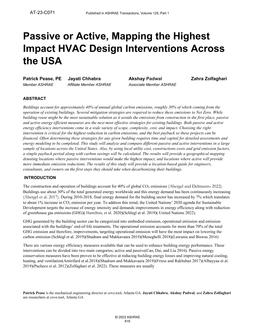
C071 — Passive or Active, Mapping the Highest Impact HVAC Design Interventions Across the USA
- Comments Off on C071 — Passive or Active, Mapping the Highest Impact HVAC Design Interventions Across the USA
- ASHRAE
Click here to purchase
Buildings account for approximately 40% of annual global carbon emissions, roughly 30% of which coming from the operation of existing buildings. Several mitigation strategies are required to reduce these emissions to Net Zero. While building reuse might be the most sustainable solution as it avoids the emissions from construction in the first place, passive and active energy efficient measures are the next most effective strategies for existing buildings. Both passive and active energy efficiency interventions come in a wide variety of scope, complexity, cost, and impact. Choosing the right intervention is critical for the highest reduction in carbon emissions, and the best payback so these projects can be financed. Often determining these strategies for any given building requires time and capital for detailed assessments and energy modeling to be completed. This study will analyze and compare different passive and active interventions in a large sample of locations across the United States. Also, by using local utility cost, constructions costs and grid emission factors, a simple payback period along with carbon savings will be calculated. The results will provide a geographical mapping denoting locations where passive interventions would make the highest impact, and locations where active will provide more immediate emission reductions. The results of this study will provide a location-based guide for engineers, consultants, and owners on the first steps they should take when decarbonizing their buildings.
Product Details
- Published:
- 2023
- Number of Pages:
- 10
- Units of Measure:
- Dual
- File Size:
- 1 file , 1.9 MB
- Product Code(s):
- D-AT-23-C071
- Note:
- This product is unavailable in Russia, Belarus

